













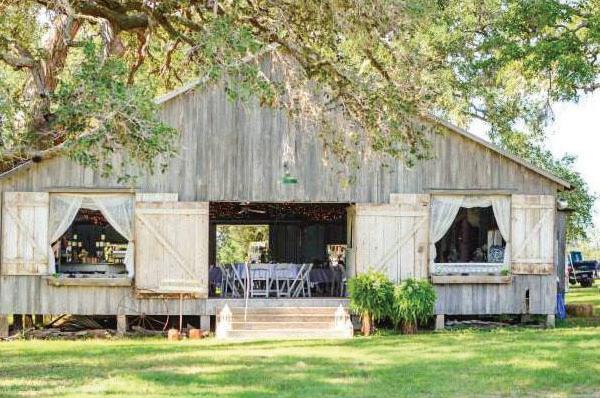
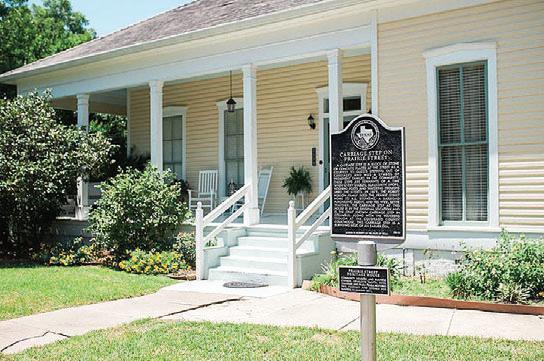




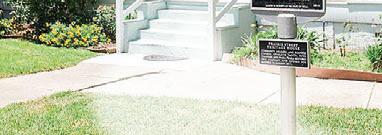










































GENERAL MANAGER
TRESSA ALLEY tressa.alley@coloradocountycitizen.com

REPORTERS
TRENTON WHITING trenton.whiting@coloradocountycitizen.com
SHAYLA KUYKENDALL shayla.kuykendall@coloradocountycitizen.com
MISSY THERIOT melissa.theriot@coloradocountycitizen.com
PHONE NUMBER (979) 732-2304
WEBSITE www.coloradocountycitizen.com
ONLINE
/coloradocountycitizen
@coloradocountycitizen


@CCCitizen
Published by Granite Media Partners

2024 Hwy 71 South, P.O. Box 548, Columbus, TX 78934, periodical postage paid at Columbus, Texas. POSTMASTER: send address change to P.O. Box 548, Columbus, TX 78934.
Any erroneous reflection upon the character, standing or reputation of any firm, corporation or individual which appears in this publication will be carefully corrected once brought to the attention of the publisher. The publisher reserves the right to refuse any advertisement.
Vintage Hamilton printing trays with original typesetting equipment that was used to produce the paper still inside. Nestled on the top are some cameras from Ricohflex, Olympia, Minolta and Canon that range over the years. Over the ages these items have been used in the making of The Colorado County Citizen.
TOWN BIRTHDAYS
4 History recognized as county towns hit milestones
STEPPING BACK IN TIME:
5 Celebrating 40 years of history at the Prairie Edge Museum


COLUMBUS MURALISTS


8 New murals align with Columbus’ Bicentennial
EAGLE LAKE DEPOT
11 Touring the Eagle Lake Depot Museum
VOICE OF COLUMBUS
14 The voice of Columbus celebrates its 50th anniversary
CITIZEN HISTORY
17 Origins of the Citizen
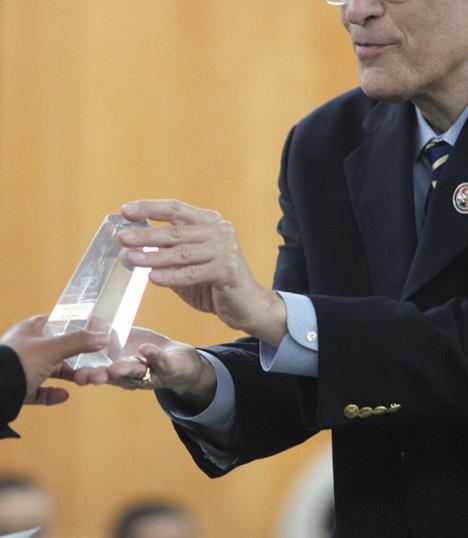
MORE THAN A MAN
18 EL Mason Lodge reaches 150 years
OVER 160 YEARS IN PUBLICATION
20 Meet the Baker family behind the Colorado County Citizen


 BY TRENTON WHITING
BY TRENTON WHITING


The United States of America declared their independence from Great Britain on July 4, 1776. Before the US had even reached retirement age, the town of Columbus set its roots just 47 years after the nation was established. As one of the oldest towns in Texas, Columbus has had generations of history pass amongst its roads and school hallways. This year, Columbus celebrates its 200th anniversary to remember some of the history that helped shape the community and recognize the significance of being one of the state’s oldest towns established in the nation’s first century of independence.
The community once known as Beeson’s Crossing took shape in a plot of area on the Colorado River as Benjamin Beeson ferried people through its waters. Stephen F. Austin’s ‘Old Three Hundred’ settlers like brothers Robert H. and Joseph Kuykendall first populated
the lands near the Texas river and established the town that changed its name in 1835 to Columbus, the name the town still wears 200 years later. Not long after adopting its current name, Columbus became the county seat of Colorado County after it was established in 1836.
Columbus has seen the rise of several different industries inside of its city limits as the town has produced wood works, gravel, cigars, cotton and much more as they created a local economy that provided opportunities to the generations of Columbus families that have been reared up through the streets of the family-oriented city. Horse-racing and town bars provided some merriment and amusement for the residents who found a little extra time on their hands.
With the Bicentennial celebration here for the citizens of Columbus to remember and recognize the rich history they hail from; the town has placed significance on the roots their ancestors set on the same lands back during the colonial times in the US.




Around 50 years after the town of Columbus first erected homes and raised families from its settlement, settlers in the surrounding areas were beginning to fill up the supple areas around the Colorado River as more and more early colonists came to populate the area. The land where Weimar would eventually be founded actually had many settlers finding their way in the area before they officially founded the city of Weimar in 1873.
The colonists near Weimar converted themselves into a township in anticipation of a railroad being built through the town that would be able to receive goods all the way from Galveston in the south. The community first began with the name Jackson after landowner D.W. Jackson donated some of his property to allow for the railroad and the townsite to be established.
Railroad mogul and investor Thomas Wentworth Peirce, the president of the Galveston, Harrisburg and San Antonio railroad company hoping to track through the community, coined the name the town currently adopts after crediting a pleasant visit to Weimar, Germany. The railroad significantly boosted the town’s economy, becoming a center of trade with the goods and services.
After the town’s inception, they went through a period of growth as residents found their niche in the economy selling consumable products like dairy and poultry. Just ten years after the city’s founding, Weimar already boasted a population of over one thousand people living within its limits. In contrast compared to that first decade of explosive growth, the town has averaged an overall increase of about 250 people per ten years ever since. Weimar’s history has been in the spotlight as it moves through its 150th year as an official township: the yearly Gedenke! celebration highlights how important the history of the town is to its residents with a specially organized event this year to celebrate the milestone.
 BY SHAYLA KUYKENDALL
BY SHAYLA KUYKENDALL
Located off of Main Street in Eagle Lake, the Prairie Edge Museum stands as a place where people can discover a lot not just about Eagle Lake’s history, but also the history of Colorado County.
Many who pay a visit to the museum do so to frequent its thrift store, which plays an integral role in the museum being able to function. The museum is also able to operate due to the help of volunteers over the years.
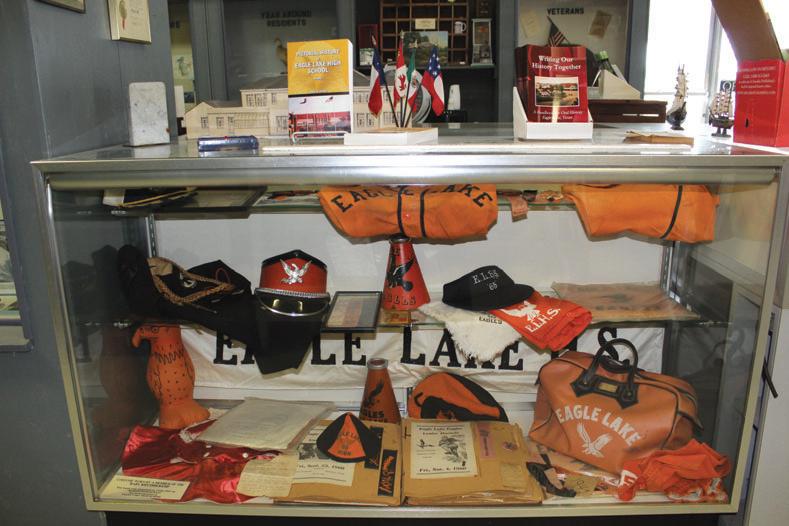
Christine Owen started working at the museum in 1967 as a bookkeeper until 1970. She later joined the board of the museum in 2000 and was elected treasurer, a position she still holds. As she provides a tour of the museum and its thrift store, she notes that before the museum came what it is today, it actually used to serve the town in a different way.

The building was built in 1926 and became a car dealership. After being sold it was used in other ways including as a gas station.
The idea for the museum began in 1975 when David Wintermann received a letter from Rollin Baker, director and curator of the Michigan State University Museum at East Lansing and with ties to Eagle Lake, being married to Mary Waddell. Owen said Wintermann suggested that a history-oriented group of citizens develop some means of preserving the history of rice farming and the heritage of residents past activities and way of life.
In 1982, several interested Eagle Lake citizens began to dream of a museum for the town. Among those were Eula Wintermann, Ada Cook, Herman Boothe, Robert Samuel Martin and Rollin Baker, who was now a resident of Eagle Lake.
Owen said about the same time, another group of citizens were organizing revitalize Eagle Lake, Inc., a corporation to help promote the economy of the town. Paulette Klockman, wife of the city manager, headed this group. Owen said the two organizations found many common interests and began meeting in the city council room where the many aspects of creating a museum began to be discussed. Some brought old items to the meetings and a “show and tell” project began.

The first milestone was to secure a building. Revitalize Eagle Lake took on the challenge of raising funds for a down payment, obtained a loan from the First National Bank and purchased the Jim F. Miller Ford Agency building for $65,000. Volunteers were recruited for the massive clean-up job, painting, removing partitions and construction of display cases.
Owen said some of the volunteers were Louis Schorlemmer, Franklin Reese, George Matthys, Elizabeth Boothe, Bill Harrison, Ted Brunner, Marcus Gunter, Ann Matthys, Elfie Thomas, Edward Priesmeyer, Mary Baker, Rick Christ, Obie Rhodes, and many more.
In 1983, the museum officially opened. The name Prairie Edge Museum was chosen because the term “Prairie Edge” refers to an ecological situation where open lands and wooden lands meet. In this particular area, the environment is ideal for rich plant and animal life.
A stage was built so that the museum could sponsor melodramas to help raise funds. Garage sales were held and donations from the Eagle Lake residents contributed to the funds necessary to pay maintenance costs and to reduce the outstanding mortgages on the building. Many of the display cases and materials were provided by the local businesses. Owen said residents loaned or donated a large number of items of interest for the museum to display and still do. She said the inventory of old tools and farm implements came from a large collection belonging to M.L. Randle, a close personal friend of Bill and Helyn Farris. Owen said this display added greatly to the farm implements already donated by the Waddell and Brunner families.


While walking around throughout the museum, there are fossils, typewriters and even a bank teller booth that was in the local bank. All of these were donated to the museum. The first television in Garwood, doll houses and more are also on display. Owen said there are some DVDs of oral histories and events like farming and trail rides also at the museum in addition to extensive files that are available for research. She said families have come by before to make copies of these and take back with them.

The education of the town is also on display. Before the neighboring schools in the local cities consolidated to become Rice Consolidated Independent School District, there was Eagle Lake High School and E.H. Henry. Those who visit the museum will have the opportunity to learn about each school and its history.
Owen said over the years, Mae Ashby was in charge of a group of volunteers and other residents bringing donations. It has grown into one of their largest outreach projects. When Lois and Martin Herman joined the work at the museum, it grew again utilizing the auditorium as a sale room.
When covid forced the museum to close its museum and thrift store, the museum asked volunteers to take a break. However, the museum said with so many people working from home, their donations have increased.
“I went to the museum every day to empty the donation box and storing the donations wherever I could find an empty space,” Owen said. “This closing caused the museum to lose the income which totally supported it. With the help of the volunteers, we are now earning enough to pay operating expenses, but not enough to hire staff to open every day.”
The museum said they have donated jackets, shoes, pants, and shirts with the schools for children in need. “Besides the schools, we have some donations that the nursing home can use and this year we shared coats and jackets with a coat drive by the Sugar Land KC’s and the last of them going to the Star of Hope Downtown Houston,” Owen said.
The Prairie Edge Museum also has a history of donating to the Friends of the Library auction.




Last year, the museum said they donated a commemorative poster of the first world series game played in Texas. It did not sell for $2 at the thrift shop sales, but with the provenance and an added cap and coin (both Astros 60th year items) it sold for $1,000.

The museum is open on Mondays through Fridays from 9 a.m. to 1 p.m. for self-guided tours. Those who would like to visit the thrift store can do so the first and third Saturday from 9 a.m. until noon.


 BY SHAYLA KUYKENDALL
BY SHAYLA KUYKENDALL

You only turn 200 once and this year, the city and residents of Columbus did all of the prep work needed to help make this year of celebrations memorable.
This year, A Better Columbus, a nonprofit created to make Columbus better, decided to add two new murals prior to the Magnolia Days Festival, which was celebrated May 19-20. ABC President Billy Kahn said that everything aligned when looking for muralists to complete the project they envisioned.











After reading a front-page article in Texas Co-op Power Magazine about Matt Tumlinson and his murals, Kahn said he knew he wanted to work with Tumlinson to help with the mural project.
“In 2021, [Tumlinson] came into Columbus and he and I drove around, and we made notes, took pictures and looked around town and looked at probably 30 possibilities, but came up with three that he really liked,” Kahn said.






Last summer, Kahn said he worked with another ABC volunteer to start finalizing locations for the murals. They sent the locations to Tumlinson, and one of them he had recently approved of, an area close to the courthouse square on Milam Street.
Kahn said it was important to them that the artists have their full creative powers over the project they would be painting.
Tumlinson said he wanted to create a mural that was unique and true to the town.
“We wanted it to kind of be a centerpiece for people taking pictures and build on the murals that are already here,” he said.
Columbus has a e of one of them m is near r the courthouse square e entitled, “GGreetings from m Columbus,” , which h is also o a t of A Better r Columbus in jo j int effort
Th That mur l al was p i aint d ed y in 20222.


Columbus has a couple of murals, one of them is near the courthouse square entitled, “Greetings from Columbus,” which is also a product of A Better Columbus in joint effort with the Columbus Chamber of Commerce. That mural was painted by Tyler Kay in 2022.

Tumlinson’s mural features four different scenes including the Colorado County Courthouse, Stafford Opera House, gas stations with Tesla charging stations, and the Colorado County River.

mural features different scenes the Colorado Courthouse, gas stations with Tesla stations, and the Colorado River “
“The courthouse and the opera house are pretty prominent, but the thing with the gas stations, it’s you know, 110 miles to San Antonio, and I think it’s another 90 to Austin, and back in the day, automobiles could only go so far,” Tumlinson said. “So, [U.S. 90] was just like 20 gas stations in like a two-block area, because that’s how far cars could get from Houston before they needed to refill, so we kind of played off that. But then, you know, now we’re getting electric charging cars and Tesla’s and stuff, so we’re kind of in that same like...they can go a little ways, but it’s like they all kind of have to stop at the same spot.”
The gas station scene has Sam Houston riding on a motorcycle with the message underneath the scene, “Historic stop on the ‘Runaway Scrape’.” Some of the names on the gas stations in the scene are “Columbus Gas” and “Magnolia Petroleum Co.”
Tumlinson said that as he was thinking about the vision for the mural, he also wanted to play off the old, southern feel that Columbus has. He said the big porches, trees and Magnolia present in Columbus helps to make the town feel like Texas.
“Enjoy timeless charm!” is the message written under the courthouse scene with an older Victorian couple as the woman holds a selfie stick.
The Stafford Opera House scene has two men in western apparel facing each other with guns with the caption, “Exiting night life!”
“Experience the Colorado River!” is the message written under the scene with a man water skiing.









“Riverboats used to come all the way up here and paddle wheel steamers. So, I wanted to include that and actually, the Moccasin Belle is what I included on this one and that was an old steamer.... but there’s an old house three or four blocks down the road [from the courthouse square] where the anchor of this old paddle wheel steamer is in front yard. Appar-
ently, there used to be a lot of that kind of commerce going up and down the river on those things back in the day.”
Tumlinson currently residing in San Antonio and is an eighth-generation direct descendant of John and Elizabeth Tumlinson, one of the first families to settle in Columbus in the 1820s. Tumlinson describes painting the mural as a full circle moment.


“What’s cool now is seeing there’s a real value in murals with social media and people kind of





tagging you, tagging your work, or tagging Columbus in it. And I think places like A Better Columbus sort of recognized that there’s a true economic value if you get written up in Texas Highways or a newspaper, it’s like, well, you need a visual and a lot of times murals are it. So, I’m really glad that towns are starting to realize that murals bring people here and then there’s all this other stuff that they can find. I think it symbolizes that a town is you know, investing in itself, which is really cool.”

“In my head, I hope that some kid is coming by and looks at it and go ‘oh, man...somebody can do that? That’s crazy.’”
— MATT TUMLINSON
Tumlinson said while he has always been painting and drawing and doing art in the studio, he finds something special when painting murals.
“Murals specifically I really like because it’s you know, that’s not in some rich guy’s house, like anybody that’s coming to town can see this. And, you know, from a personal standpoint, I grew up in a smaller town and we didn’t have galleries or anything and so, you know, kind of my exposure to big bright murals from the outside world was you stop at a train track and a train will go by and like all that graffiti will be on there and I’d go, ‘this is wow, man.’ So, that kind of sparks your imagination for what to do.”
Tumlinson started working on the mural prior to the Magnolia Days Festival and put the finishing touches on it the last day of the festival. He said the perception has been positive from the community.
“In my head, I hope that some kid is coming by and looks at it and goes ‘oh, man...somebody can do that? That’s crazy.’ I had that epiphany early on...knowing that somebody has done it is important.”







Christen Horner was tasked with creating the mural on Walnut Street, adjacent to the courthouse square. The mural is named “Artist Alley,” a name after the area that was recently approved by the city council earlier this year.
Kahn said, “It was sort of serendipitous that city council had upgraded that alley and given it a name. The idea is to liven up that alley at least from the backside of the Live Oak Center all the way down to Walnut Street to make it colorful, to make it hip, to get it lit up at night, and to make it an entertainment alley from the art center to Hound Song Brewing Co. to The Old 300, it sort of connects them all together. So, we at ABC felt like this would be a great place to start decorating that alley and we picked an artist who felt that she could portray the concept of the various arts in her mural.”
Horner recalls when she was asked to paint the mural.
“Immediately, my mind went to somebody holding out the palm of their hand and breathing life into a world,” she said. “To me, my art form, my art, painting...is my world. It’s my life. It has changed me. It’s taught me, it’s grown me, it’s given me roots...I hope that it breathes life into everybody that sees every creation that I make. I want it to make an impact somehow in their life. Breathing life into your art form is important.”
Horner said the style for these mural falls under the impressionistic art form, but also branches into the realism category. She mentions how the ballerina and musical notes on the mural demonstrates this principle.
“It goes to the ballerina and then the song from the ballerina comes back to my mouth. So, we give our art to the world and what they do with it, their joy and their happiness, it comes right back so it’s a full circle,” she said.
Horner also said one of her favorite things of this experience has been hearing people’s thoughts on the mural. Comments like “it is so bright; you can see if when you drive down the road.”
One day when Horner was painting the mural, a family approached her. They were from Katy but had a ranch in the area. She got acquainted with the family and even let them help her paint the confetti on the mural. She especially enjoyed seeing the joy in the children’s faces.


“They felt like they were on cloud nine,” she said. “It was wonderful. It was really cool to see the spark in such a young child’s eyes.”
Horner’s overall hope when people see the mural is that they feel encouraged and uplifted.
“I hope that when they see this that something stirs within them,” she said. “I feel like there’s a creative piece in all of us and I hope it encourages them to unleash that, take the lid off of whatever jar they placed themselves in, and then allow themselves to breathe life and to get some roots. Dig down and let some roots go.”

“Breathing life into your art form is important.”
— CHRISTEN HORNERCourtesy photos



 BY SHAYLA KUYKENDALL
BY SHAYLA KUYKENDALL
The Santa Fe Depot at Eagle Lake was built in 1911 and later opened in September that year. It is a combination of a passenger and freight depot with two waiting rooms, an office area, a baggage room, and a large freight room. The Eagle Lake Depot Museum said the last passenger train departed in 1956 after a decline beginning in the 1920s. The Eagle Lake Santa Fe continued in freight service until 1970, when the agency was transferred to Lakeside. After its service to the railroad ended, the museum said the Santa Fe Depot was sold to private interests. The building was used in a variety of businesses including farm implement dealer, dentist office, beauty parlor, apartments, and an internet service office before being returned to its appearance during railroad service in 2000.
Ken Stavinoha at the Eagle Lake Depot Museum gives visitors a tour of what life was like for many during the time the railroad was in operation. He explains the history of the depot and also provides visitors with demonstrations of the lights, sounds and ways people used equipment and other uses of the train for daily transportation.

Walking into the agent’s and clerk’s office, a constant clicking sound like someone typewriting can be heard.

“What you’re hearing there is how they would communicate with the train dispatcher. It’s like air traffic control at the airport,” Stavinoha said. “The dispatcher knew where every train was, but he didn’t have the nice computer and software and stuff. He knew because every agency along the way would telegraph him when the train left the station.
He had his big sheet about three yards...he knew where every train was on his district.”
Stavinoha describes the office as the “heart of the depot” because it helps keep everything running fluid. He said passenger trains, also known as hotshot freights, ran on a tight schedule compared to local freights which did not have a predictable schedule because of the time needed to load and unload cars.
Moving into the baggage or freight room, was a baggage wagon used to transport passenger baggage between the depot and the baggage car on the train. The wagon was not used inside the depot at the time, but it is placed there now for museum purposes.
“This is where the Wells Fargo stuff happened and passenger baggage... Everything here, of course there’s no cardboard, just mimics 1918, so everything is wood, or it’s a crock or a bag, something like that,” Stavinoha said.
The baggage cart contained poultry crates, containers to ship tomatoes, apples, peaches and other produce, cases to ship cheese, even barrels for surface nails. He said some of the barrels and containers used are still used today.

The room also contained the hitching posts that would be used so horses would not run during the process of loading and unloading the wagon.
“Before trains, pretty much Pony Express is how the mail was handled,” Stavinoha said.
Signs on the wall include Wells Fargo & Express and American Railway Express. The museum said the Santa Fe Depot became the express office for Eagle Lake in October 1911. The room showcases the note that Wells Fargo & Company Express was the predominant express company in Texas, and was used by the Santa Fe. The museum further notes that before U.S. Mail began to handle larger parcels, the express companies provided this service. The major express companies were consolidated in 1918 to become the American Railway Express Co, which was eventually bought out by the railroads in March 1929 and renamed the Railway Express Agency.
The large freight room is now the exhibit room and contains railroad crossing signs, lanterns, and more. Some of the windows, mailbox and wood panels from the train depot in Eagle Lake that burned down in 2011 were also on display.
Stavinoha said that the Santa Fe was one of the last of the train stations that were opened in Eagle Lake. At one time, there were as many as four in the city.
The side of the exhibit with lanterns is where visitors will learn a lot about the history of the railroad signaling system.
“One thing people don’t know is that our traffic colors red, yellow and green came from the railroad,” Stavinoha said. “Actually, the British were ahead of us on this because they had railroads. They were doing railroads before we were, and so when we start to come up with signaling, you got to find a way to communicate something to a person with what they should do, because there’s no mobile communications right now. So, this idea of the semaphore arm that could be seen
in the daytime dates back to the early 1800s.”
Stavinoha said when the arm is straight up or vertical, it means to proceed, while horizontal mean to stop.
“Before 1900, white, which was basically a kind of a flame behind a lens, was actually the proceed indication because there wasn’t a lot of light at night, and green was caution and red was stop.”





He said a colorblind test was done to come up with the colors so that people would be able to tell the difference in the color changing and understand what the message was signaling. He said this later became a problem when ambient light started to become sufficient at night resulting in changing the colors to green to indicate proceed, introducing amber for caution and red to stop.
Some of the varieties of lamps are also on display, such as switch lamps for changing tracks and marker lamps, which are on the back of the train or caboose to give them authority to move.



The depot museum also features a model train layout of Eagle Lake in 1924. Stavinoha describes it as a favorite exhibit for those who visit. The train layout features several buildings including the Farris Hotel rice dryers and shows how a train would have run through the town, to the depot and departing. A timetable on the wall of the exhibit showed the schedule for when passenger trains would be arriving.
One of the things people may not know about the depot is that on Saturday, April 9, 2011, celebrated its Depot Centennial commemorating 100 years. Stavinoha said it was done in April out of precaution for hurricane season.
He said they had reenactors, the high school band played, and he said he was thankful to be able to talk to those in attendance.
“Part of our job is we the stories of the station agent. I mean, you still have engineers and conductors, you know, but we don’t really have any agents anymore. And there’s nobody really to tell their story, so we tell their story,” he said.
After the centennial celebration, Stavinoha said the museum was open more regularly. He also said within the last five years, a lot of what is on display today has been donated.
The depot is now a 501(c) 3 non-profit organization, Eagle Lake Depot, Inc. It is dedicated to overseeing the restoration and maintenance of the rich transportation history of Eagle Lake and the surrounding area.
Search Eagle Lake Depot, Inc. on Facebook to learn more about the history of the museum. Tours are available the second and fourth Saturday from 10 a.m. to 3 p.m.
































YellaWood® brand pressure treated pine stands unrivaled in providing the best available protection against rot, fungal decay and termite attack. And even better, it’s proudly produced right here in Columbus, Texas. Enjoy the uncompromising beauty of a backyard made with high quality natural wood products from YellaWood® brand pressure treated pine. Find your local dealer at yellawood.com/ findus.







 BY TRENTON WHITING
BY TRENTON WHITING


While on the way from Houston into the towns of Colorado County, travelers may notice that the normal channels on their radio receiver are changing as they drive farther away from the broadcast area. As radio listeners flip through the channels to find some easy listening on their drives, they are likely to end up tuned in to the flagship radio station of Columbus, 98.3 KULM and 92.3 KNRG. The radio station has been a staple for the citizens of Columbus for years as people can look forward to hearing easy-listening country music, game coverage of Columbus sports and announcements and news around the country. Along with the rest of the anniversaries being celebrated in the county this year, KULM also has cause for celebration as they enter their 50th anniversary after becoming a syndicated radio channel in 1973.

Before the station could become such a staple of the community, it needed a pioneer to lead its inception. John L. Labay turned out to be the

leader and founder that KULM needed to build from the ground up and begin its journey into becoming the consistent voice of the community. After spending some time running his own radio show in El Campo, Labay eventually felt compelled to bring the power of radio to Columbus.


‘From the ground up’ is meant quite literally as Labay not only completed the process for receiving a license to broadcast and requesting the permits to construct a transmission tower, but he also built the physical location the station broadcasts from with his own hands and tools. That same building from 1973 stands today as the original location and the current studio. He hired Lillian Stallman as his first employee and radio personality as he established a legacy of broadcasting in Columbus. While managers and DJs have come and gone since the station’s first broadcast on Aug. 1, 1974, the influence of Labay and his passion for providing Columbus with the news and media that radio uniquely features persists in the daily operations.

There have been a few people who occupy front row seats to see what exactly has changed and what has stayed the same over the station’s lifetime. Legendary radio voice Carl Geisler watched









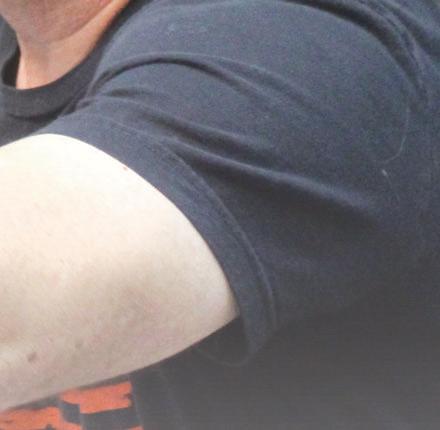



and commentated on the progress of Columbus for decades until his relatively recent retirement. Geisler has not gotten too far away from the booth either as he still airs on a part-time basis at the station. Judy Barrett was an original member of the station as well and has filled many roles since joining the team. Barrett has seen every step of the process from its initial construction and broadcasts to the transition into the digital media age.

“When I started working here, we had to hand type the log each day with all the commercials on it,” Barrett said, “There couldn’t be a mistake on it, it had to be perfect. You couldn’t use whiteout.”




From cassette players to eight tracks, to CDs and then the advent of the computer, Barrett saw the progression of the station with her own eyes as the town they covered changed as well. The KULM staffers watched the construction of HWY 71 connect with U.S. 90 in real time from the office window as they worked daily to provide the stories of Columbus to the airwaves. KULM has overseen and broadcasted news, sports, events and much more as they have documented history and disseminated vital information, keeping the people of Columbus informed with their voice.

“In 1973, the citizens really welcomed the radio station,” Barrett said, “we’ve had a lot of faithful listeners that probably have listened all 50 years... And I hope that we’ve brought some joy to the people of Columbus”





Of course, the ‘voice’ of Columbus would not be nearly as effective without an actual living, breathing voice to carry its delivery. For the daily KULM listeners in Colorado County, it would be hard to imagine a morning without the voice of either longtime host Carl Geisler or country singer and show host Darrel Appelt coming in through the radio. Appelt has been a presence for the station since 1985 after initially helping out running programs while he was still in high school. After heading off to college in San Marcos, Appelt was made aware of an opportunity by Geisler to take full-time position at the radio station in Burnet. There, Appelt learned all the skills of radio broadcasting before Geisler returned in the early 2000s to offer Appelt a chance to come bring his voice back to Colorado County.






“If you’re willing to work, things will work out,” Appelt said.





Two of the most iconic voices in the station’s history worked in concert for years, providing local coverage and stories unique to a local media station. And in fact, collaboration is a huge part of how things are still run at the station today. Every piece of the puzzle fits together to help the operations run smoothly, even as challenges arise. Along with Barrett and radio personalities Geisler and Appelt, Ricky Canik is another important DJ with a large polka listenership, Cindy Wilde who takes care of production and office duties, and Debbie Bosque who helps with sales. All these impactful people contribute to the important duties of keeping the station going while all being led by general manager Ryan Henderson and his father Roy Henderson who owns the station and several stations throughout Texas.
With so much history already within the walls of the Columbus radio house, reaching the 50th anniversary is an important milestone for the station that has been on the call and narrating the growth of a community for half a century. While there are no plans set in stone about a celebration, DJs of the past that have sat at the booth in Columbus themselves have already reached out in hopes of an event being organized by the end of summer or in the fall.

As the town continues to grow and change, KULM looks to be the resounding voice that allows important local stories to be heard throughout the county. After fifty years of being just that, they hope that their role in the community is something that never changes.


















































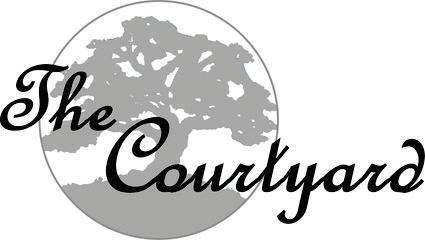

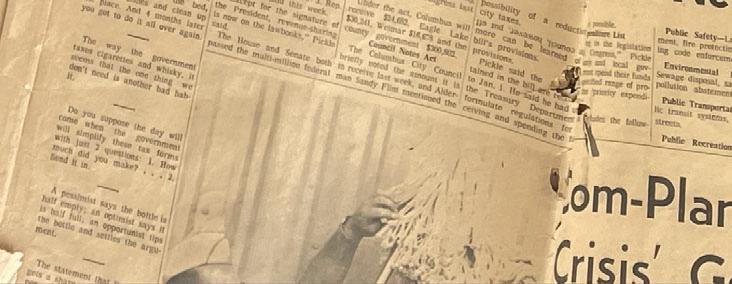



The Colorado County Citizen, a weekly newspaper, was established in Columbus in 1857 by James Davis Baker and named the Colorado Citizen by Rev. J. J. Scherer Baker’s younger brothers, Benjamin Marshall and A. Hicks Baker, owned minority interests in the newspaper. All three brothers joined the Confederate army; publication of the newspaper ceased during the Civil War. Hicks Baker was killed during the war, and James and


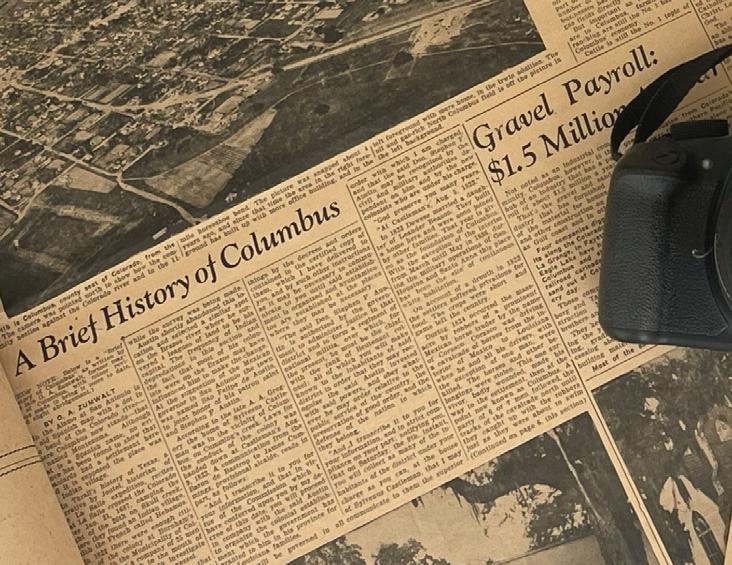



Ben returned to Columbus to resume publication of the paper. When James became ill, the paper was sold to Fred Barnard, and its name was changed to the Columbus Times. In 1869, Barnard, who had subsequently sold the Times, started a second paper, resurrecting the name Colorado Citizen. Barnard sold the paper to three Columbus law firm partners, Robert Levi Foard, Wells Thompson and George McCormick in 1871; they sold it back to Barnard the following year. Ben Baker, who had been hired by Barnard to work on the new Colorado Citizen, bought the newspaper in 1873 and served as its editor and publisher until his death in 1907. The
yellow fever epidemic in 1873 and a fire in 1880 caused brief suspensions of the publication of the paper. After Baker’s death, the Citizen survived repeated changes of ownership. Henry Hurr purchased the paper from W.L. Pendergraft in 1924 and changed the name to Colorado County Citizen in 1927. Beginning Feb. 17, 1993, it was published by the Citizen Publishing Company, a group of local citizens. In the 1990s, the paper had a circulation of over four thousand. The newspaper was purchased by Granite Publications in September 1998, and again in 2021 by the rebranded Granite Media Partners.



 BY TRENTON WHITING
BY TRENTON WHITING
How can a good man become better? The importance of that question to the ideals of the freemasons has been the core principle behind their operations and beliefs. The freemasons: a society of men (now incorporates all kinds of people) that emphasize strong moral character and charitable acts towards the community with a benevolent attitude. Freemasons believe in self-improvement and aligning your actions with a greater purpose. Patriotism, religion and self-sacrifice are all traits that are encouraged and are nearly requirements for the men seeking to further their understanding on their relationship with the world and their fellow men. All the values of the masons have culminated in Eagle Lake in the Grand Mason Lodge located in the town’s historic commercial block. The Lodge stands as a historical marker in the town’s history as well as the masons of Eagle Lake celebrate 150 years of service and dedication to the community this year.
Before Texas had even been ratified as a US state, the Masons began their relationship with the Lone Star as early as 1835 when the first Masonic meeting convened to discuss bringing the lodge into the state. The Masons present had all been part of Lodges in Louisiana and wanted to bring the Masons influence into their new home, which at the time, was its own sovereign nation. The Grand Lodge of Louisiana issued a charter for this first Lodge of Texas and eventually aided in the formation of two more Lodges in the Republic. These three Lodges convened for another meeting, this time in Houston, to establish an official “Grand Lodge” for Texas comparable to Louisiana’s Grand Lodge in the United States at the time. The Grand Lodge of the Republic of
Texas formed in 1837 and elected Anson Jones, the fourth and final president of the Republic, as the first Grand Master of Masons in Texas. Now, the influence of the freemasons persists throughout Texas as several important figures in its history took up the Mason mantle. Davy Crockett, Stephen F. Austin, Sam Houston, William Barrett Travis, and even Buzz Aldrin later are just a few of the significant Texans to become Masons in their lifetimes. The significance of the Masons cannot be overstated, as other famous Masons such as George Washington, Wolfgang Amadeus Mozart and Benjamin Franklin all represented the true values of the Masons.
When the town of Eagle Lake looked to requisition their own Lodge in the community, they understood the history and significance that came along with it. Eager to bring the influence of the Masons into the small Colorado County town, the EL Masons received a charter to establish their Lodge on June 9, 1873 and elected
B.C. Jones to be the first Worshipful Master, otherwise known as the Lodge’s highest ranking official. The Masons experienced several significant moments in their Eagle Lake history even from its initial actions. In 1880, they established what is now called the Masonic Cemetary that stands as a historic landmark in Eagle Lake with many area leaders and
their families finding their forever homes amongst its grounds. The first ever building constructed for the Lodge burnt down after a year of construction and preparation in 1883. The EL Masons did not let that hurdle hinder their progress in the town as several years later in 1891, the Masons moved into their first, full-time Lodge that remained in use for nearly 30 years.
After three decades of use, the Lodge was no longer adequate for meetings in Eagle Lake. The Masons then hired G.W. Keith to take the lead in building a new physical location in 1912. That building from the early 1900s is where the Eagle Lake Masons still meet today, benefitting from the work and craftmanship of Keith over a century ago.
Since then, the Lodge has done many positive things for the community and contributed wherever possible. They have had ceremonies for schools and local buildings and constantly support the education of the community’s youth.
Long time Mason and Eagle Lake Lodge’s soon-to-be Worshipful Master Kevin Binder was part of a legacy of Masons in his family before he grew to such an important position for the Masons in his community. Since 1999, Binder has been spreading the message of community and growth in honor of his masonic heritage and his conviction in the values himself.
“I am part of five generations of Texas Masons,” Binder said, “All the men in my family are Masons and [when] I asked my grandfather how I could become one, my Masonic journey began at that point.
When Binder takes on the position as the Worshipful Master of the Lodge, one of his charges in the first year is to recognize and celebrate the historic milestone of 150 years that the Lodge has reached in Eagle Lake. Plans have
already been set to have the anniversary celebration at the local Eagle Lake Community Center for a celebratory dinner that is open to the public. High-ranking officials of the Grand Lodge of Texas will be in attendance as well as the Masons recognize the significance of such a historic foundation in Eagle Lake.

Outside of the anniversary, the Lodge hopes to continue with initiatives like their high-school graduate scholarships that aid graduating seniors in Eagle Lake with the cost of college as they move on to the next stage in becoming contributing members of society themselves. The Masons will also continue to recognize the great acts by their community with awards such as the Community Builder Award for an individual that has gone to great lengths to aid Eagle Lake, and the Lamar Medal to recognize outstanding educators in the town. The Lodge also hopes to participate in all of Eagle Lake’s public events as well to help keep a visual presence in the city.
As Eagle Lake Lodge #366 enters another year of its rich history led by Binder, they will be

looking to “carry on the traditions and work” of every former Mason that established this path for the current generation. Those interested are always invited to attend meetings at the Lodge on the second Thursday of each month for dinner and further information.
While the Masons continue to build significant history within the town of Eagle Lake, they can feel satisfied knowing they are continuing an already rich and full history of Masonry in Colorado County and Eagle Lake.
Benjamin Marshall Baker was born on March 12, 1827, in Louisiana. He was the son of Job Mcnamee Baker (1792-1878) and Sarah (née Carter, 1802-1858). While he was still very young, Benjamin’s family moved to San Antonio, Texas where, as a boy, he learnt the printing trade.
In 1857, Ben moved to Columbus, Colorado County, Texas to work on the “Colorado Citizen”, a newspaper that his brother James Davis Baker had founded and that his other brother, Hicks, also worked on. In early 1861, Benjamin enlisted in Echo company, made up of volunteers from Colorado County and, thereby, joined the war between the states. His unit became Company B of the Fifth Texas Infantry, Texas Brigade, Army of Northern Virginia – the famous “Hood’s Texas Brigade” . His company took part in some of the bloodiest battles of the war, to great renown, including Eltham’s Landing, Second Manassas, Sharpsburg, Gettysburg, Chickamauga, The Wilderness and Petersburg amongst others.
Whilst serving in the Fifth Texas, B.M. Baker wrote letters home. These were published in the “Colorado Citizen” and, whilst some are probably lost due to many issues of the newspaper no longer being in existence, the surviving letters tell of his experiences from assembly at Lookup Camp near Harrisburg, via transit through Canton, Miss., to arrival in Richmond, Virginia. Ben Baker acquitted himself well. He was listed as Sergeant on entry into the regiment and ended the war as first Lieutenant. Returning from the war, he went back to working on the newspaper with his brother, James (Hicks had been killed in the war). They ran the paper until approximately October 1866 when they sold it to a local attorney, Fred Barnard. Barnard changed the newspaper’s name to the “Columbus Times” but later sold it. In 1869, he and Ben Baker established a new newspaper under the “Colorado Citizen” name. They ran this newspaper for many years and had to cope with closure during the yellow fever epidemic of

1873 and after a severe fire in the office in February 1880. After a name change to the “Colorado County Citizen” in 1927 and a succession of different owners, Ben Baker’s newspaper is still published weekly in print and online forms.
In 1874, Baker married Virginia (known as Jennie) F. Cunningham (1848-1916) whose father, Leander Calvin Cunningham, had military history of his own, having served with Sam Houston’s army at San Jacinto when Santa Anna was captured. Ben and Jennie had three children: Drew Cunningham (1875-1956), Ada Virginia (1877-1979) and Bennie Hester (1882-1960). Drew married Miss Eva Coffee of Columbus and had three children. Ada married a Mr. Rabel of Harlingen and Bennie married a Mr. Ramey of Dallas (although one record has Bennie named as Mrs. Stine in 1807).


For many years, Benjamin Baker was one of the most prominent newspaper men in the state. He is also known to have done many good
deeds and charitable acts which caused him to be mourned widely when he died at his home in Columbus of heart failure, aged seventy, on Dec. 8, 1907. His burial place is in Odd Fellows Rest Cemetery, Columbus, Colorado County, Texas.
In early 2021, over 113 years after B.M. Baker’s passing, as an English old west re-enactor, new to the scene, I was researching the Confederate army, trying to learn some background information but also unsure as to what impression to portray. As a member of the Original Lonestar Old West Reenactment Group, which is set in about 1885, and being in my mid-fifties, my character could easily have taken part in the war between the states, hence this particular line of research.

Whilst reading “The Bloody Fifth” by John F. Schmutz, I came upon some details about Benjamin Marshall Baker. This gentleman had the same surname and even the same date of birth, March 12, as me (albeit 130 years apart).
That settled it; the coincidences could not be ignored. Benjamin Marshall Baker was a newspaper man so I, Richard Francis Baker (no known relation), would create the impression of a newspaper man.
The group members think that I portray the only old west newspaper character in the United Kingdom, at living history events and also by means of a group newspaper and a Facebook page. My newspaper’s name is inspired by Ben too: the “Lonestar Citizen”. I do not re-enact as Ben Baker; we recreate tented frontier towns so carrying a printing press and all the rest of the equipment with me would be impractical. However, my impression is a newspaper reporter and that is in acknowledgement and remembrance of Benjamin Marshall Baker, Fifth Texas Infantry, Colorado Citizen newspaper.

Richard F. Baker, reporter and editor, Lonestar Citizen, an imprint of The Original Lonestar Old West Re-enactment Group.







































































